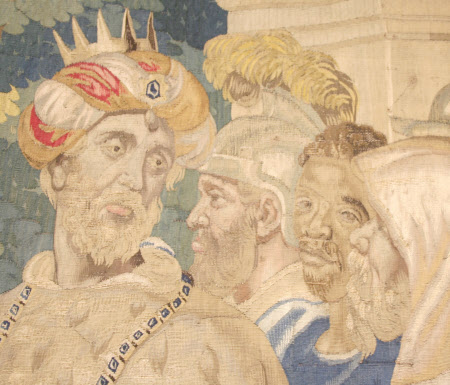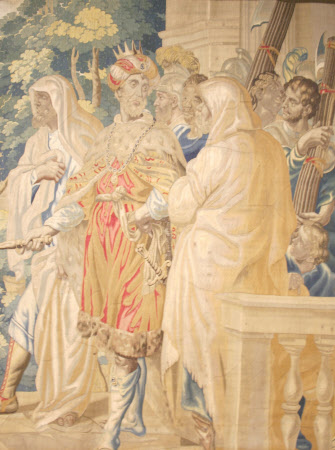A Procession to the Temple of Janus (Numa Pompilius)
possibly Jan Frans Cornelissen (d.1678)
Category
Tapestries
Date
circa 1670 - circa 1685
Materials
Tapestry, wool and silk, 6 warps per cm
Measurements
2950 x 5150 mm
Order this imageCollection
Cotehele, Cornwall
NT 348295
Summary
Tapestry, wool and silk, 6 warps per cm, Procession to the Temple of Janus, Antwerp, Jan Frans Cornelissen, c. 1670-1685. A large rectangular tapestry hung around a corner. On the right hand side is Numa Pompilius, wearing an ermine-lined robe, a jewelled necklace and a crown hung with a large jewel over his turban. He is surrounded by a crowd of people including robed priests, soldiers wearing plumed helmets and men carrying fasces. Numa Pompilius gestures with a staff to a chariot laden with arms and weapons which is being drawn by a team of horses towards a round temple on a hill in the middle distance on the left. The chariot has rams’ heads attached to its cross-bars and is followed by men blowing horns. Small figures climb the steps to the temple and through the open door spears and other weaponry can be seen arranged inside. The upper border is composed of swags of fruit and flowers suspended between clam shells with a blank cartouche in the centre. In the side borders are winged putti supporting cornucopia, and female figures supporting laurel wreaths and vases of flowers. The lower border is missing. The tapestry has been folded under by approximately 20 cm at the bottom.
Full description
Numa Pompilius reigned as the second King of Rome after Romulus between 715 and 673 BC. His story is told by both Livy (Parallel Lives) and Plutarch (Life of Numa Pompilius). Numa was chosen as King by the senate and people of Rome due to his wisdom. Having had retired from country life to Cura, the news of his choice as king was brought to him by the Roman Proconsul and the King of the Sabines, Veleso. Numa’s peaceful instincts, his love of study and his religious sensibility initially led him to refuse the office, but his family and friends persuaded him that Rome was in need of his guidance. As King of Rome Numa sought to found the city anew on the basis of peace, not war, He dismissed the armed guard that had accompanied his predecessor Romulus, and sought to make alliances with his neighbours. According to Livy (History of Rome, 1.19) he also built the temple of Janus at the foot of the Aventine Hill as an index of peace and war, to signify when it was open that the State was under arms, and when it was shut that all the surrounding nations were at peace. The mythic figure of Janus was known as a lover of civil and social unity, who reclaimed men from brutal and savage living; he was also a god of beginnings, and gave his name to the month January which, according to Plutarch, Numa moved to the beginning of the year (Plutarch, Parallel Lives). Janus is represented with two faces, one looking the past and one looking to the future, and his head can be seen over the doorway to the temple in this tapestry. The chariot of arms that Numa sends to the Temple may represent his banishment of warlike trappings from Rome, and the priests surrounding him allude to his strong religious sensibility, and the new priestly offices he founded. The designer of the 'Numa Pompilius' tapestry series is unknown, but the style is very similar to another series woven by Cornelissen, ‘The History of Caesar Augustus’ (of which three panels survive at Cotehele), whose design has been attributed to Justus van Egmont (1601-1674) - indeed one scene from the set, ‘Numa Pompilius offered the Throne of Rome’, virtually repeats the composition of one of the scenes in the ‘Caesar Augustus’ series (Forti-Grazzini 1994, pp. 338-9). Both the ‘Numa Pompilius’ and ‘Caesar Augustus’ series were probably woven in the Antwerp workshop of Jan Frans Cornelissen (fl. 1662 – d. 1678). Cornelissen was the brother-in-law of Jacob Wauters, father of Philip and Michiel Wauters who were responsible for many of the tapestries at Cotehele. The records of the Antwerp Art dealers the firm Forchoudt contain numerous references to Numa Pompilius tapestries made by Cornelissen and, after his death, by his niece Maria Anna Wauters (Denucé 1931, passim). The earliest reference, in 1669, describes a set of eight panels with the following subjects: ‘The Roman ambassadors offering the throne to Numa’, ‘The arrival of Numa in Rome’, ‘The Coronation’, ‘Numa having the arms transported to the temple of Janus’, ‘The Legendary marriage of Numa with the nymph Egeria’, ‘Numa and Egeria with the Muses’, ‘Numa with the philosophers’ and ‘The Triumph of Numa Pompilius’. Numerous surviving examples from the ‘Numa Pompilius’ series have been recorded, but they have often been mis-identified, most commonly as scenes from the History of Caesar Augustus (see for example Marillier 1930, pp. 15-18). Among the most impressive is a single panel of ‘The Roman Ambassadors offering the throne to Numa’, in the collection of the Quirinale, Rome (Forti-Grazzini 1994, pp. 338-341), in a border decorated with military paraphernalia. The border on the tapestry at Cotehele is far simpler and alludes not to the warlike character of Rome but instead, through the winged Putti carrying cornucopia, to the peace and prosperity that were established during the reign of Numa Pompilius. In his account of Cotehele published c. 1840 the Rev. Arundell wrote that in the Best Bed-Room (as the South Room was then called) “behind the bed appears to be a Roman triumph, or a procession to the temple of Janus.” (Arundell 1840, p. 27). This suggests that although in the same room, the tapestry hung in a slightly different position to today. (Helen Wyld, 2011)
Provenance
First recorded at Cotehele c. 1840; left at Cotehele when the property was accepted in lieu of tax from Kenelm, 6th Earl of Mount Edgcumbe (1873-1965) and transferred to the National Trust in 1947; amongst the contents accepted in lieu of estate duty by H M treasury and transferred to the National Trust in 1974.
Credit line
Cotehele House, The Edgcumbe Collection (The National Trust)
Makers and roles
possibly Jan Frans Cornelissen (d.1678), workshop possibly Maria Anna Wauters (c.1656 - 1703), workshop probably Justus van Egmont (Leyden 1601 - Antwerp 1674), artist
References
Delmarcel, 1999: Guy Delmarcel, Flemish Tapestry, Tielt 1999 Forti-Grazzini, 1994: Nello Forti-Grazzini, Gli Arazzi (Il patrimonio artistico del Quirinale), 2 vols., Rome 1994 Hefford, 1991: Wendy Hefford, The Cotehele Tapestries, The National Trust, 1991 (n.p.) Marillier, 1930: Henry C Marillier, English Tapestries of the Eighteenth Century, London 1930 Arundell, 1840: The Rev. F V J Arundell (illustrated by Nicholas Condy), Cothele, on the banks of the Tamar, London c. 1840



